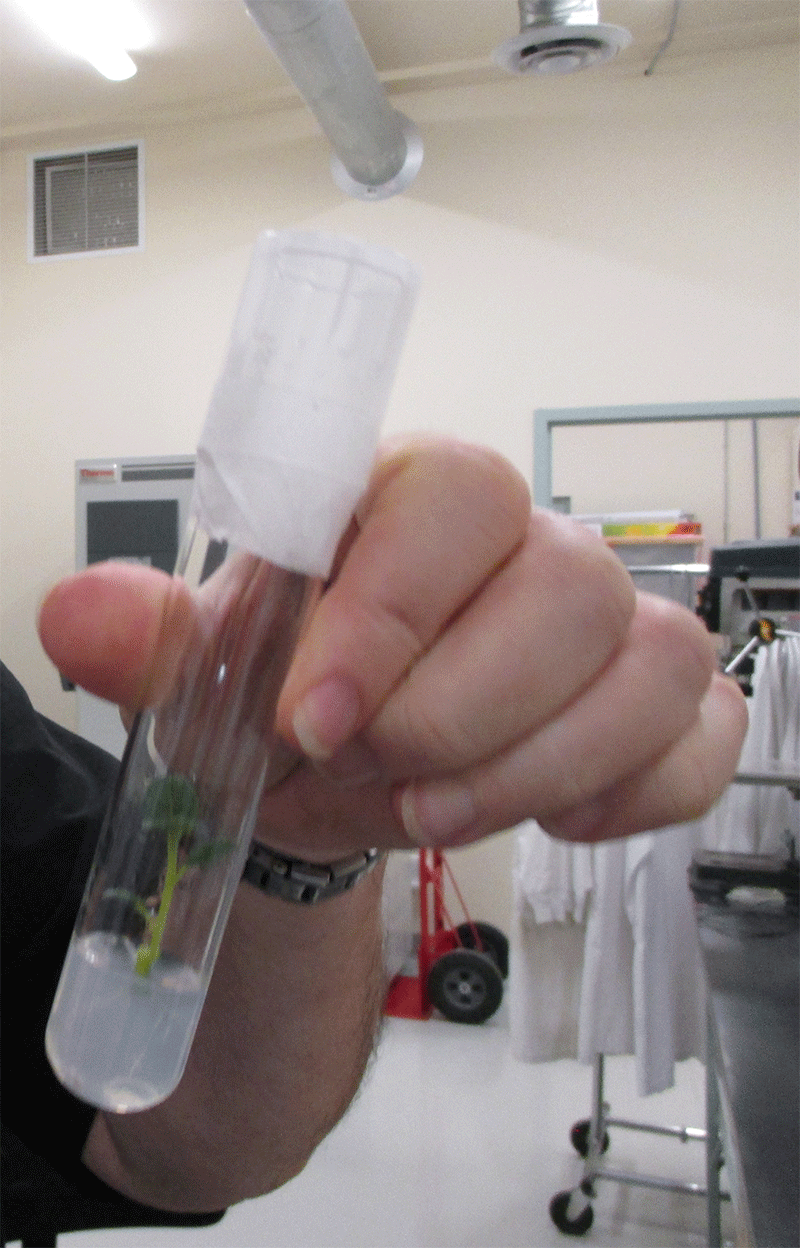Soil technology
IDENTIFYING MICROBES WITH DNA BARCODING
AT CANADA’S OUTDOOR Farm Show, one can’t help but notice machinery getting bigger each year. But when it comes to new technology in the agriculture industry, the biggest developments are not in iron or horsepower; in fact, they are practically invisible.
PHOTO: TESTING SOIL MICROBES TO DETERMINE WHICH ARE MOST FUNCTIONAL TO THE PLANT

Soil microbes are so tiny that it would take over a thousand of them lined up in a row to stretch across the period at the end of this sentence. Just a teaspoon of soil can contain billions of bacteria and metres of fungal hyphae strands, and they play an integral role in soil health and plant growth.
This microscopic world has been relatively unknown to us but, in the last decades, genetic sequencing has opened up a new frontier of exploration.
Dr. Kari Dunfield is the Canada research chair in environmental microbiology of agro-ecosystems and an associate professor at the University of Guelph. “We can’t grow these soil microbes easily in the lab,” Dunfield explains, “but we can now use DNA barcoding to identify which microbes are there.”
“Using next generation sequencing technology, we can identify nearly every species within a soil sample,” says Dr. Robert Hanner, from the Biodiversity Institute of Ontario (BIO) at the University of Guelph. “There are many different applications in agriculture. It allows us to identify weed seeds and insects, for example, even based on only fragmentary remains that would otherwise not have been able to be identified.”
Hanner and Dunfield are partnering with other researchers, with support from Grain Farmers of Ontario, on a project to characterize Ontario’s soils based on microbiology.
“We want to get baseline data on different soil types and also make this DNA-based assessment accessible for farmers to test soils for biology, the same way they would for inorganic parameters,” says Hanner.
Ultimately, researchers want to know which microbes are doing what.
FIELD STUDIES
Dr. George Lazarovits is the research director at A&L Biologicals and his team is doing just that. A few years ago, they compared two management systems near Dunnville, Ontario. Dean Glenney used no-till, controlled traffic, alternating strips of corn and soybeans, and relatively low inputs for his 300-bushel corn yields. By comparing with a neighbouring field, Lazarovits discovered that the microbial communities between the farms were dramatically different.
“In Glenney’s corn field there were more microbes but less diversity, as if they had reached a critical mass in order to create a function for the plant,” he explains.
The project has now scaled up to over forty corn fields across Southwestern Ontario. The team flies drones to get NDVI maps and compares samples between the highest and lowest yielding areas of each field.
“We determine which species are present, but what we really care about is what functions are being amplified in that soil,” explains Lazarovits. “We ask how many nitrogen-fixing genes are present or how many phosphate-solubilizing genes, for example.”
A&L Labs is testing the biology in the corn roots and tissue to determine which microbes are most functional to the plant.
“The plants themselves are an ecosystem,” says Lazarovits. “We now understand that the microbes are selected by the plant, and that the organisms that are present in the soil are not necessarily going to be the ones that are being used by the plant.”
Research is revealing the complexity of interactions within this invisible ecosystem. Lazarovits points to a Japanese study, which determined that millet inhibits the ability of bacteria to convert ammonium to nitrate. His own research at Glenney’s farm found a cover crop of Austrian winter peas gave a 15 per cent yield bump in the corn, which averaged 345 bushels over the test strip.
“This stuff isn’t new,” Lazarovits says, as he pulls a few books on soil microbiology and green manures off his shelf. “These were written before 1930, but still they are the most up-to-date ones I have,” he laughs.
UNDER THE MICROSCOPE
We are rediscovering the importance of microbes, but now with new technology. And researchers aren’t the only ones peering through microscopes; a few Ontario farmers are also seeing for themselves.
Mike Sieve farms soybeans on 2,500 acres near Alfred and was fascinated with soil biology after attending a workshop with Elaine Ingham, an American soil microbiologist.
“I bought a microscope with 600 times magnification for only $300,” Sieve says. With the microscope, he hopes to understand how best to increase microbial activity on his farm and is beginning trials with a liquid inoculant called compost tea.
“Increasing the microbes is one thing, but they need to have something to eat,” Sieve continues. “So I’m also trying cover crops so that living roots are feeding microbes for as many days of the year as possible.”
Gord Speksnijder, along with his brother, is a chicken producer farming 350 acres near Port Hope. He is using a microscope to help assess the impacts of manure, compost and cover crops on the biology in their soil.
“While I’m not able to identify individual species of microbes, I can at least get a read on their diversity. My goal is to introduce as broad a mix of microbes as possible, do my best to keep them alive, and hope that the plants will figure out the rest,” Speksnijder laughs. “The concept of raising ‘soil livestock’ is so intriguing I just had to take a closer look.”
“Our research is clearly showing that management such as tillage and cover crops can shift the composition of microbial communities,” says Dunfield. “And we’d like to know how this affects things like nutrient cycling and organic matter composition.” •






















